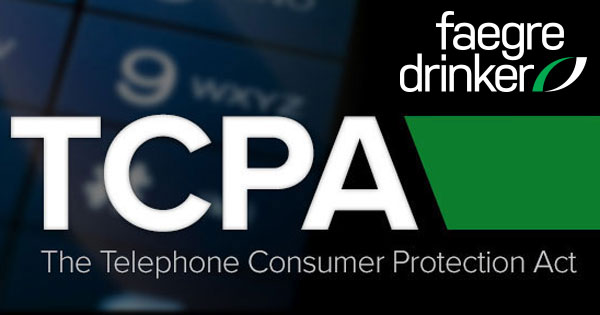As we have reported here and here, courts throughout the country, including most notably the Eleventh Circuit in Salcedo v. Hanna, have grappled with the question of whether a single unsolicited text message may constitute sufficient injury to satisfy the constitutional standing requirement in Article III. The Salcedo court held that one text message does not suffice.
But what about a single fax? That was the question recently presented to the Middle District of Florida in Daisy, Inc. v. Mobile Mini, Inc., No. 20-0017 (M.D. Fla. Sept. 24, 2020). The court similarly found that, at least under the relatively unique circumstances of the case, a single fax did not confer standing.
To be sure, it appears that the outcome in Daisy would have been different had the plaintiff received the fax by “traditional” means, i.e., by a fax machine. Instead, the defendant sent one unsolicited fax advertisement to plaintiff’s fax number, which plaintiff then received as an email attachment because it subscribed to an online service, Vonage, which, the court explained, “acts as a sort of middleman, collecting then sending [plaintiff] its faxes attached to e-mails.” This fact, alone, was dispositive, as it distinguished the case from others involving occupied phone lines and printing costs. The court even acknowledged that that plaintiff “would have standing” if “this were a regular fax case.” In this atypical case, however, the court ruled that plaintiff’s alleged harm did not satisfy Article III, and it dismissed the action without prejudice.
The court began by explaining that, to satisfy Article III, a plaintiff must show (1) injury in fact, (2) causation, and (3) redressability. With respect to the injury requirement, which the Supreme Court discussed at length in its seminal opinion in Spokeo, Inc. v. Robins, 136 S. Ct. 1540 (2016), the injury must be (1) “concrete and particularized” and (2) “actual or imminent.” A “bare procedural violation” of a statute is not enough.
The Daisy court found that the plaintiff did not show a concrete, actual injury separate from the TCPA violation. Without grounds to argue that the fax tied up its phone lines, caused wasted ink, toner, or paper, or otherwise cost money (the plaintiff was not charged per fax), the plaintiff could allege only the intangible harm of wasted time because its employee, who could have been working, “wasted one minute reviewing the fax, deciding it was junk, and dragging the e-mail to his spam folder.” Plaintiff tried to distinguish this wasted minute from the “seconds” allegedly wasted by the single text in Salcedo. However, as Salcedo held, an alleged concrete harm based upon “wasted time” ultimately requires a “qualitative, not quantitative” analysis. As the Daisy court explained, the “quality of harm — not the counting of seconds — decides concreteness.” Accordingly, Daisy concluded that there was no qualitative difference between deleting an unwanted text vs. deleting an unsolicited fax received by e-mail.
The court continued its analysis, however, because there was no precedent on the issue of faxes received by email. The court followed Spokeo’s directive to consider (1) history and (2) the judgment of Congress. Neither supported the plaintiff’s claim of injury.
As for history, the court found that the plaintiff’s alleged harm did not have a sufficiently close relationship to any historical causes of action, perhaps “because history knew no parallel for the harm of wasted time spent reviewing a junk fax received by e-mail.” Indeed, common law torts — including trespass to chattels, trespass to land, conversion, invasion of privacy, and nuisance — did not squarely fit, as each involved a greater interference with a traditional property right.
As for congressional judgment, the court observed that the TCPA expressly prohibits sending unsolicited faxes to a fax machine, but “it conspicuously left out faxes sent to computers.” So there was no indication from the statutory text that Congress intended to protect the plaintiff’s alleged harm. Nor did any congressional findings support plaintiff’s position, as they mostly concerned residential telemarketing calls. The legislative history also suggested that Congress was primarily focused on avoiding printing costs for faxes and occupied phone lines, rather than wasted time. Congress’ subsequent legislation did not alter the equation. Congress amended the TCPA through the Junk Fax Prevention Act but did not address faxes received by email. By contrast, where Congress had regulated e-mail in the CAN-SPAM Act, it specifically sought to address the harm of wasted time. Finally, the Daisy court noted that the FCC had recently agreed in two recent rulings that faxes sent to online services did not cause the harms Congress sought to protect against in the TCPA.
Ultimately, the court found that “Congress did not view one wasted minute spent reviewing a junk fax received through e-mail as a concrete injury.” Daisy thus serves as a helpful reminder that a plaintiff in federal court must not only prove the elements of a claim, but must also satisfy Article III’s standing requirement. While this hurdle is not necessarily insurmountable, Daisy exemplifies a case where a line must be drawn. Of course, the defendant’s victory was fortuitous; the outcome turned on the fact that, unbeknownst to the defendant, the plaintiff had opted to receive its faxes via email instead of by a fax machine. While the defendant surely intended to and did send an unsolicited fax to a fax number, the fact remains that the plaintiff’s actions precluded the type of harm that would satisfy Article III.
Although the facts of Daisy may be unusual, TCPA defendants should always consider whether there is something about their plaintiff or their facts that might make a standing challenge viable.

